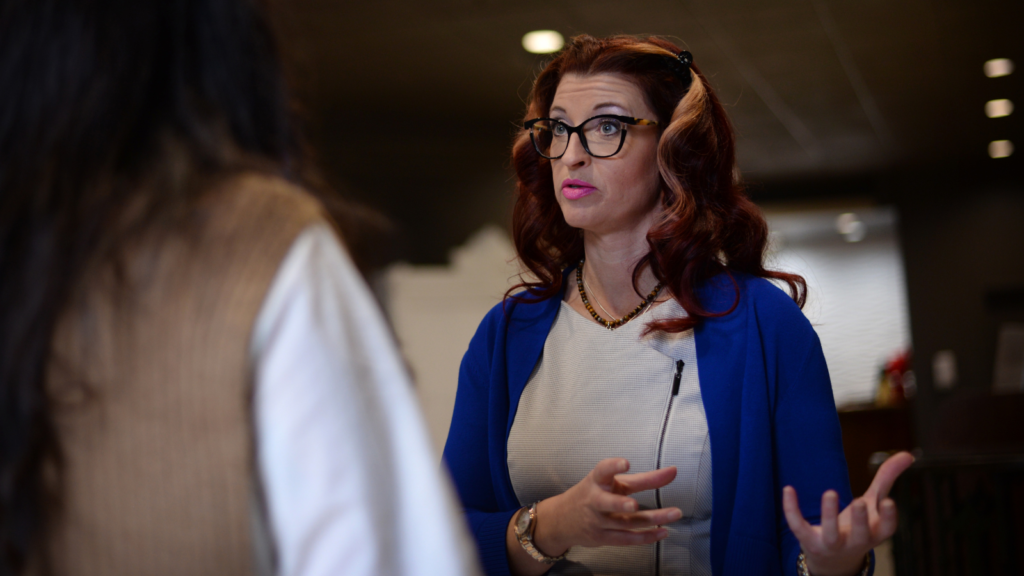Fly my encrypted data to the moon — or to the Canadian Space Agency’s first quantum communication satellite anyways

Katanya Kuntz is a a quantum physicist and CEO and Co-founder of Qubo Consulting Corp. — Photo by Jennifer Friesen, Digital Journal
“Imagine a rat’s maze,” says Katanya Kuntz, a quantum physicist, CEO and co-founder of Qubo Consulting Corp.
She’s explaining how quantum technology works, during an interview with Digital Journal at Calgary Innovation Week.
You’ve got a rat at one end of the maze, and cheese at the other end. A classic computer is going to test out one path at a time, to figure out which path will get them to the cheese.
“But a quantum computer can try all possibilities simultaneously at once, and then find the path,” she said.
Which means, it figures out the best path much more quickly. And that’s thanks to quantum physics.
Here’s how quantum physics and technology work:
“We’ve had quantum physics for more than 100 years,” Kuntz explains. It’s the study of the microscopic building blocks of pretty much everything in the universe — like atoms. And they have different, rather wacky rules that we’re not used to experiencing in everyday life.
Some of what we understand about these building blocks or particles (their principles or rules) has been applied to what were called Quantum 1.0 technologies for a while, says Kuntz.
Essentially, everyday tools like lasers, LED lights, electronics, MRI and x-ray machines are created by applying the foundational principles of quantum physics to a technological process.
To return to the rat maze analogy…
In quantum physics, one of the “basic” rules is that a particle can exist in multiple places, simultaneously.
A particle doesn’t have a fixed location until we look at it. This happens because particles behave like waves of probability rather than fixed objects. Until we observe or measure a particle, it’s in a state of uncertainty, where all possible outcomes coexist.
So a quantum computer can explore every different maze path that’s possible, all at the same time.
Cool, huh?
It gets cooler though, because these days, scientists are working on technologies that use the more complicated quantum principle of entanglement to create “quantum networks” or a “quantum Internet” that will enable next-level data encryption. It’s Quantum 2.0.

How Quantum 2.0 is going to protect our data so it’s unhackable
An exciting example of Quantum 2.0 technology is Canada’s first quantum communication satellite that’s set to launch in 2025 or 2026, which will help secure our data in a whole new way, says Kuntz.
In addition to her role at Qubo, Kuntz is the science team coordinator for this mission, which is called the Quantum EncrYption and Science Satellite (QEYSSat), and is owned by the Canadian Space Agency.
What’s the satellite going to do exactly?
The QEYSSat science team is going to beam a laser up from the Earth to communicate with it.
“So there’s a ground station in Waterloo, Ontario,” Kuntz explains, “It’s literally a telescope … we’re going to shoot a laser up.” And this will be a “quantum uplink” sending particles of light — called photons — up from the ground to space.
Quantum communication systems are sent to space because satellites allow secure communication over long distances, something that’s hard to achieve on Earth due to interference and the limited range of ground-based fibre systems.
These photon signals can be used to encode and encrypt everything from online banking to sensitive transaction records to private government data, and are much, much more secure than any of the other encryption technologies we use today.
“With quantum, you can actually encrypt the information securely. So it’s theoretically 100% secure,” explains Kuntz.
And this level of encryption is increasingly necessary as hacking and ransomware threats become a bigger concern, she says.
“Calgary’s Public Library system got hacked about a month ago and was held hostage, and they still don’t have internet, computers, printers, anything electronic. There’s literally a sign when you walk into the public libraries here that says, ‘no technology.’ And you can take out books, but you can’t return books because they can’t check anything.”
How and why we need quantum satellite encryption:
When you encode information on the individual photons, if a hacker is trying to access your data, it will affect the light stream, and you’ll know because you’re monitoring that channel, says Kuntz.
“This is to everyone’s benefit,” she says and is part of the Canadian government’s quantum strategy, prepping for the day when the first quantum computers come online. This could happen in the next five to 15 years, says Kuntz.
“There’s around 20 countries already that have quantum satellite missions, so we’re not the first,” she says. But the value of having our own in Canada is to establish our own secure quantum network.
“So it’s our national sovereignty to have our own quantum Internet. It protects our own public information.”

Everyone else needs to prepare for our quantum future too
It’s not just governments who need to prepare for the quantum future, says Kuntz. Businesses and organizations can (and probably should) start looking now for quantum solutions to their problems.
And by problems, she means almost any challenge that includes a lot of complex variables.
For instance: “There are cities that are using quantum optimization algorithms, like Tokyo, to improve their transportation and waste management,” Kuntz says.
Some of the complex challenges quantum can help navigate include:
“If there’s events in the city, how is that going to affect the waste management? If there’s [extra] traffic flow, if there’s [unexpected] weather events, if there’s suddenly a snow dump, that’s going to really affect your routes, and maybe your garbage trucks won’t get to all their stops.”
Quantum tools can help provide solutions in situations like these, that are faster (like our rat to cheese scenario) and ensure the data involved is more secure (with next-level encryptions).
The speed and security of quantum can be used to improve the efficiency of every sector from finance, to aviation to agriculture and manufacturing, Kuntz says. “It’s not just one industry. This is touching every single industry in the world.”
She also notes that companies and organizations alike need to be prepared for when quantum computers come online, because they’ll be able to hack anything that isn’t quantum encrypted.
“Elect somebody in your company to be your technology evangelist, and have a small budget for their training.” Once they understand quantum a little better, Kuntz recommends sending them off to find people and tools who can help do a “cryptographic inventory” of your assets.
“Engage with a quantum company and start exploring,” she says.
Fly my encrypted data to the moon — or to the Canadian Space Agency’s first quantum communication satellite anyways
#Fly #encrypted #data #moon #Canadian #Space #Agencys #quantum #communication #satellite





